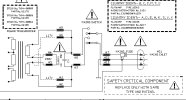fractalsoup
New Member
- Joined
- Apr 26, 2015
- Messages
- 12
- Reaction score
- 4
Hi, I have TSL100. Keeps blowing mains fuse when switching on. Have tested all valves in a tester and no shorts. Even without power tubes in mains fuse still blows. (In UK so T2A).
Looking for guidance on how to test if the mains transformer has gone bad. Have multimeter but dont have a variac. Do have a 30V power supply for basic hobby electronics though so in theory could test for voltage in circuits.
If PT ok then thinking input board (rev 3) has bad film caps.
On mainboard the 2 main capacitors 330uF @ 315V look bulging on top. Would they blow a mains fuse if bad?
Thanks
Looking for guidance on how to test if the mains transformer has gone bad. Have multimeter but dont have a variac. Do have a 30V power supply for basic hobby electronics though so in theory could test for voltage in circuits.
If PT ok then thinking input board (rev 3) has bad film caps.
On mainboard the 2 main capacitors 330uF @ 315V look bulging on top. Would they blow a mains fuse if bad?
Thanks

 to the forum...
to the forum...


